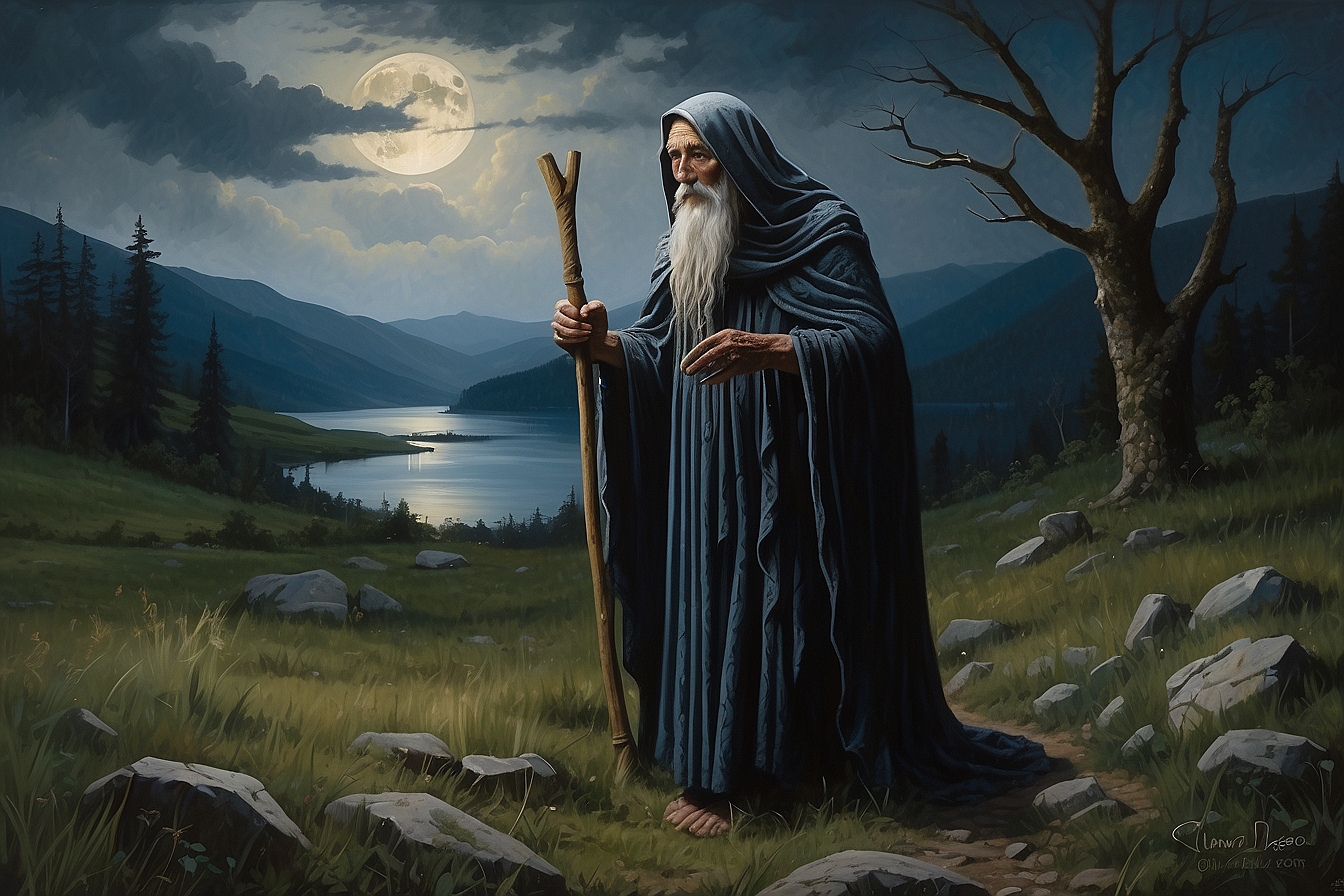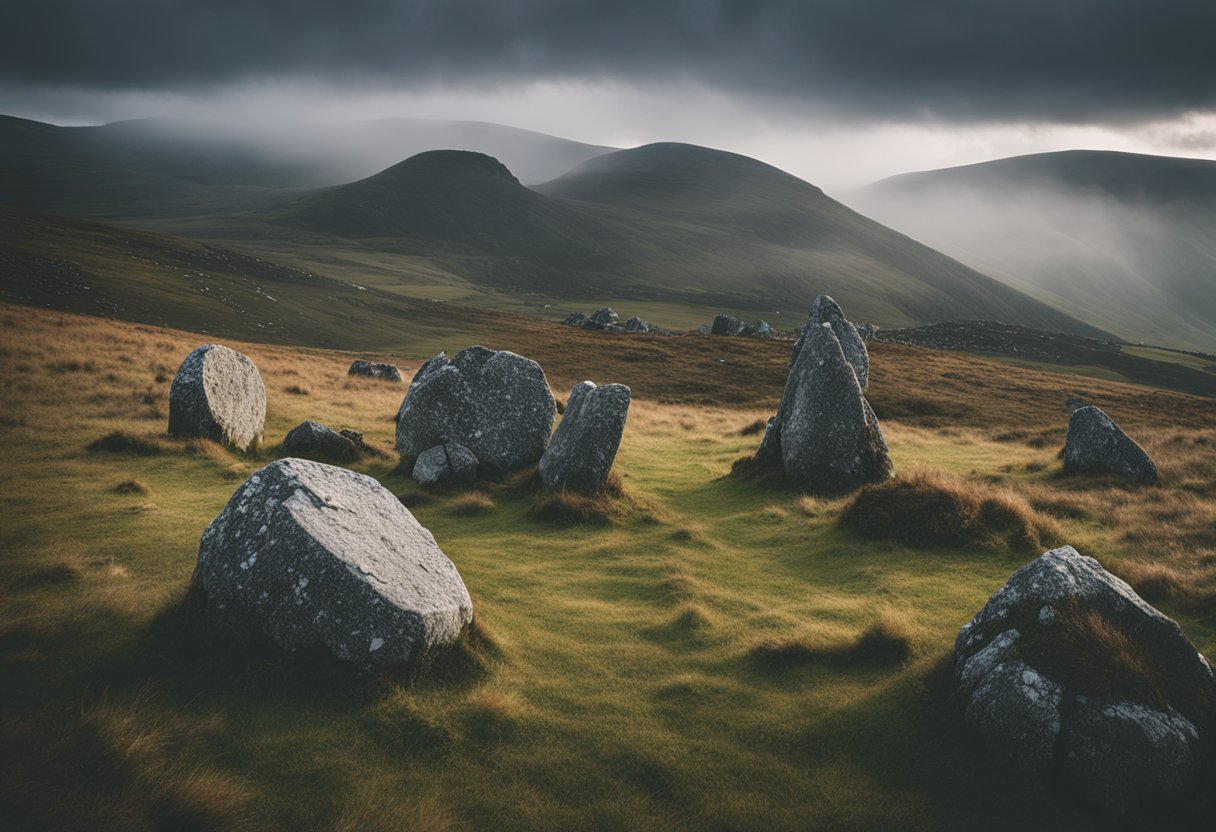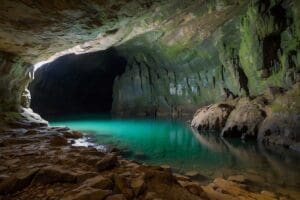The Legend of the Cailleach in Ireland: the Mystique of the Divine Hag

Updated On: April 22, 2024 by Eman Sameh
The legend of the Cailleach is an integral part of Irish folklore, deeply engrained in the Gaelic tradition and bearing significant mythological importance. This ancient figure, often depicted as a hag or old crone, embodies the harshness of winter and the elemental power of nature. Throughout Ireland’s storied landscapes, the Cailleach’s presence is felt in the enduring rock formations and stormy seas that characterise the country’s rugged beauty. She is not merely a myth; her story transcends time, continuing to captivate those who seek to uncover the wealth of Ireland’s cultural heritage.

Our understanding of the Cailleach is supported by myriad tales and associations highlighting her roles and representations in Gaelic mythology. As a shape-shifter, she takes on many forms, each steeped in symbolic meaning, from ancient stones to the fierce winter storms that sweep across Ireland. Her legacy is not confined to the past but is a living part of the Irish cultural fabric, inspiring celebrations and festivals where the old ways meld with new interpretations. The Cailleach’s legend is as varied and compelling as the landscape of Ireland itself, a testament to the enduring bond between the Irish people and the mythological traditions of their land
Origins and Etymology

In this section, we explore the deep Gaelic roots and various monikers of the entity known as the Cailleach, a significant figure in Irish and Scottish mythology.
Gaelic Roots
The term ‘Cailleach’ originates from Old Irish, with its earliest form being Caillech, meaning a ‘veiled one’. This term is believed to derive from the word caille, translating to ‘veil’. Interestingly, caille is thought to be an early loan from Latin, specifically from the word pallium, signifying a ‘woollen cloak’. The concept of a veiled or hooded woman resonates with the title ‘Cailleach’, reflecting her nature as a mysterious and ancient goddess.
The Cailleach is deeply woven into the fabric of Gaelic mythology. She embodies the essence of winter, wilderness, and the winds, playing a pivotal role as a goddess in the changing of the seasons across Ireland, Scotland, and the Isle of Man.
Other Names
Within the rich tapestry of Celtic culture, the Cailleach is known by several names that reflect her diverse aspects and attributes. She is sometimes referred to as the ‘Veiled One’ or the ‘Queen of Winter’, names that evoke her sovereign rule over the coldest part of the year and her influence on its severity and length.
In Irish tales, she is particularly associated with the festival of Imbolc, signalling the dawn of spring, and thus highlighting her integral role in the cyclical transformation of the seasons. Similarly, in Scotland, her presence is a common thread in the cultural narrative, and she’s often addressed as Cailleach Bhéara or Cailleach Bheurra. Each alias sheds light on her multifaceted nature, from being a divine hag to a creator deity within Gaelic folklore.
Mythological Significance
In exploring the legend of the Cailleach, we uncover a figure of profound importance in Irish mythology. Her narrative is not only rich with symbolism but also deeply intertwined with the very fabric of Celtic spirituality and the natural world.
Cailleach in Irish Mythology
The Cailleach is revered as a deity who embodies the essence of winter and the life cycle. In Irish mythology, she is considered a powerful ancestral figure, a goddess who can control the weather and the forces of nature. Her ability to shape the landscape through her actions, such as dropping boulders from her apron to create hills or using her hammer to forge valleys, establishes her not only as a divine hag but also as a creator in her own right, shaping the land as a mother does her child.
Connections to Other Gaelic Deities
Our exploration reveals the Cailleach’s connections to other Gaelic deities. She is sometimes linked to the goddess Brigid, with some tales suggesting the Cailleach transforms into Brigid at the onset of spring, embodying the cyclical nature of the seasons. This dual aspect of the two goddesses showcases the vast and rich tapestry of Celtic mythology, where gods and goddesses possess multifaceted roles within the realms of creation and destruction, life and death.
The Cailleach Legends
In this exploration of cultural folklore, we navigate through the enduring tales of the Cailleach, a figure deeply woven into the fabric of Irish and Scottish mythology. Recognised as the Queen of Winter, her narratives stretch from Ireland to Scotland and the Isle of Man, shaping the landscape and seasonal cycles through her extraordinary powers.
Tales Across Lands
Within Irish folklore, one cannot overlook the Cailleach as an emblem of the winter season and the natural world. Reported to be the ancient deity responsible for the harsh weather of winter, she’s often depicted as an old woman embodying the spirit of the season. In myth, she is a transformative figure with the power to shift her form into a giant bird, ushering in storms and the winter freeze. Her presence can be traced in landscapes across Ireland, where natural formations, such as the Hag’s Head at the Cliffs of Moher, bear her name, forever imprinted by her legendary acts of creation and destruction.
Moving beyond Ireland, the Cailleach is no stranger to Scottish mythology. She’s an integral part of the Scottish legends, where she’s acknowledged as the divine hag and a sculptor of the landscape, with mountains and lochs believed to have been formed by her hand. Meanwhile, on the Isle of Man, she is remembered in tales that speak to both her nurturing and destructive natures, illustrating the dual forces of creation and decay.
Prominent Myths and Stories
Venturing further into specific myths, we encounter the renowned Hag of Beara, a prominent figure in the folklore of County Cork. Carved into the very stone of the Beara Peninsula, this enigmatic legend tells us of an immortal being awaiting her husband and transforming with the seasons.
In Scottish tales, the Cailleach is often associated with the oversight of animals during the winter months, bearing witness to her as a guardian of life amidst the barren and fierce winter landscape. Her stories are marked not only by her influence on the climate and terrain but also by her function as an arbiter of nature’s balance.
Throughout these myths and legends, the Cailleach endures as a powerful symbol — one that connects us to the natural world and its cycles. Her legacy, etched into the folklore and landscapes of the British Isles, stands as a testament to the depth and richness of these cultural narratives.
Roles and Representation

In Irish mythology, the Cailleach is an intricate figure embodying the raw forces of nature. Our exploration delves into her roles and the rich symbolism she carries.
Goddess of Winter
The Cailleach is intrinsically tied to the harshness of winter. As a deity who wields the power to usher in the cold and command the weather, she is often associated with the creation of storms and the ushering in of the winter months. As a winter goddess, she is thought to control the elements, capable of freezing the ground with her staff, a clear marker of her formidable influence over the colder season.
Symbol of Sovereignty
A potent symbol of sovereignty, the Cailleach has long stood as a guardian of the land and its rulership. Her lore is interwoven with themes of power and fertility, extending beyond the winter months. It’s said that her dominion over the seasons highlights the cycle of life and death — a tangible expression of her sovereignty that transcends mere metaphor. Her duality with Brìghde, who signifies the return of life in the spring, validates the Cailleach’s place as a pivotal figure of not just sovereignty but the cyclical nature of the seasons.
Manifestations and Symbols
In Irish mythology, the figure of the Cailleach is a potent symbol of the forces of nature, often depicted in various guises and connected to numerous natural landscapes and phenomena.
The Hag’s Physical Forms
The Cailleach is most famously portrayed as an old woman or hag, a manifestation that captures her association with wisdom and the changing of the seasons. She is a multifaceted deity, hailed as a goddess of winter who is said to transform into a boulder, synonymous with the endurance of nature across time. Folklore often represents her in the form of animals—as a deer, symbolising life and vitality; a wolf, signifying the wild and untamed aspect of nature; and as an owl, the wise and seeing creature of the night. These forms all encapsulate elements of her vast domain over the natural world.
Natural Phenomena
The Cliffs of Moher, with their towering presence, are strongly linked with the Cailleach; they’re said to be crafted by her hand as she dropped rocks to form the sheer cliffs, thus creating a literal Hag’s Head in the landscape. This rocky outcrop stands bold as an eternal reminder of her influence. In other tales, the Cailleach is said to usher in the harshness of winter and preside over the raw, untouched landscapes of Ireland—her very essence woven into the fabric of the natural phenomena she governs. As we observe her undisturbed nature, we are reminded of Cailleach’s power and the rich tapestry of mythology that enshrines these elements as symbols of her presence.
Cultural Impact and Legacy
The Cailleach is a figure deeply entrenched in the cultural fabric of Ireland, with her influence extending far into both traditional Irish folklore and modern cultural representations. She embodies the harshness of winter and the sovereignty of the land, reflecting a powerful legacy on the Irish cultural and mythological landscape.
Influence on Folklore
In the realm of Irish folklore, the Cailleach Béara stands out as a primordial figure. As an embodiment of reverence in Irish society, she represents the changing of seasons and is often associated with creating landscape features in Ireland. She is said to have shaped the land with giant tools, sprinkling islands like seeds across the waters and reigning over winter from Samhain until Beltane. Intertwined with stories of fairies and natural phenomena, the Cailleach’s presence is a testimony to the respect and awe that Irish mythology holds for the forces of nature and their personifications.
Modern Cultural Depictions
Our exploration of the Cailleach’s role in modern times reveals her enduring presence. Contemporary retellings often situate her within narratives that both celebrate and re-evaluate her significance, allowing us to appreciate the multitudes within her character. She surfaces in literature, poetry, and the arts, providing a fountain of inspiration that reinforces her status as an integral element of Irish identity. Her tale continues to resonate, underscoring the persistence of Ireland’s mythological heritage in today’s cultural consciousness.
Geographical Associations

In our exploration of the Cailleach legend, we find a rich tapestry woven into the very geography of Ireland. The landscapes and landmarks of this ancient land resonate with tales of the Cailleach, while the place names and sites bear silent testimony to her enduring presence.
Landscapes and Landmarks
We observe that the dramatic natural features of Ireland seem to carry the essence of the Cailleach, with particular areas closely associated with her lore. At the Beara Peninsula, sweeping vistas encapsulate the raw beauty of nature where the Cailleach is said to have left her indelible mark. The rugged terrains of County Cork similarly reflect the harshness and the nurturing aspects attributed to the goddess associated with winter and sovereignty.
Travelling further, we note the imposing mountains that stand as sentinels across the countryside. Among these, Sliabh na Caillí in County Meath, with its ancient passage tombs, whispers stories of the Cailleach’s presence in the very fabric of its stones. The undulating valleys, often enveloped in mists, add to the mystical atmosphere that is so potent in tales of the Cailleach. Geographical features such as these not only serve as a backdrop for the legend but are often integral to its narrative.
Place-Names and Sites
Within the richness of Irish culture and heritage, certain place names and sites are inextricably linked to the Cailleach legend. Corcu Duibne, a region in County Kerry, carries echoes of the Cailleach in its name, suggesting the historic belief in her influence over the land and its people. It’s as if the very names of these places serve as gateways to a bygone era, where the line between landscape and legend is intriguingly blurred.
Our understanding of the Cailleach is enhanced by considering these geographical connections, revealing how deeply interwoven she is with the land itself. Each site we visit, and each story we uncover further cements the Cailleach’s standing in Irish myth and emphasises our own connection to this ancient landscape.
Ceremonies and Festivals
In Irish legend, the Cailleach is deeply intertwined with the cycle of the seasons, reflected through ceremonies and festivals that mark significant transitions in the traditional Celtic year.
Samhain and Imbolc
Samhain, celebrated on the first of November, signifies the end of the harvest and the beginning of winter, a time traditionally associated with the Cailleach. As she ushers in the season, Celtic celebrations involve lighting sacred fires and gathering firewood to honour her as the ruler of winter. Similarly, Imbolc on the first of February marks the end of winter and the beginning of spring, with the Cailleach returning to her stone form, symbolic of the earth rejuvenating and the well of youth replenishing itself. In the past, lit candles and fires celebrated the rebirth of nature, and rituals were performed at sacred wells.
Associated Rituals
During Là Fhèill Brìghde, or St. Brigid’s Day, associated with Imbolc, households would craft Brigid’s crosses from reeds, asking for protection from the Cailleach’s wintry might. The lighting of bonfires during Bealtaine, the first of May, celebrated the victory of summer over winter, an aspect indicating the retreat of the Cailleach’s powers as warmth returned to the land. These rituals were not mere ceremonies but embodied deep respect for the shifting balance between the Cailleach’s wintry dominion and the fertile seasons ahead.
Symbolism in Nature
In the tapestry of Irish mythology, the figure of the Cailleach is a profound symbol intertwined with the natural world, reflecting its cyclical transformation and embodying both its creative and destructive aspects.
Weather and Seasons
The Cailleach is often characterised as a storm hag, a formidable presence associated with the tempestuous weather of Ireland. Her dominion over the winter months manifests in the harsh, cold landscapes that encapsulate the darker half of the year. As the bringer of snow and ice, her presence is deeply felt in the barren trees and the frozen earth. The Cailleach’s connection to the seasons is not only that of a harsh ruler of winter but also as a creator, her actions paving the way for rebirth and renewal. With the end of winter, the promise of light and life returns, typified by the grain harvest, which is essential to the cycle of life in nature.
Flora and Fauna
Within the realm of animals and plants, the Cailleach’s touch is equally evident. She safeguards the seeds and sleeping grain beneath the earth, ensuring that life persists through the cold. It is said that she herself transforms into a giant stone during the warmer months, allowing nature to flourish unimpeded. The animals, from the mightiest stag to the smallest sparrow, all respect the Cailleach for her dual role as protector and destroyer. Their survival through the winter months can be attributed to her mercy and foresight in preserving the natural order.
Interpretations and Analysis

At the heart of our discourse are the multifaceted interpretations and analyses of the Cailleach, an emblem of life and death, and the embodiment of the crone aspect of the feminine archetype. The captivating power of the Cailleach instils both fear and awe, challenging us to explore deeper psychoanalytical views and academic perspectives.
Academic Perspectives
Among scholars, the Cailleach is often considered a complex figure representing both destruction and rejuvenation. Historically seen as the personification of winter in Ireland, she commands a formidable presence as a guardian of life’s cycle. Some academic accounts suggest that the Cailleach, juxtaposed alongside Brìghde, personifies the stark contrasts between the decay of winter and the promise of spring. This dynamic is central to understanding the Cailleach’s role, where she is not merely a winter deity but a symbol of the ever-turning wheel of life and death.
Psychoanalytical Views
Turning to psychoanalytical interpretations, the Cailleach can be viewed through the lens of Jungian analysis where she takes on the significance of the ‘dark mother’ – the crone archetype. This figure is intertwined with notions of power and transformation, edging us into the depths of the subconscious where primal fears and the collective awe for nature reside. The crone as an archetype allows us to reconcile with the darker aspects of our psyche—providing a metaphorical space to reflect on the dormant power within us during the fallow periods of our lives. The Cailleach’s sovereignty over the harshness of winter mirrors our own sovereignty over personal transformation as we navigate the terrains of youth and maturity.
Frequently Asked Questions
We’ve compiled a list of some of the most common queries surrounding the Cailleach, a significant figure in Irish lore known for embodying the forces of nature.
How is ‘Cailleach’ correctly pronounced in Irish tradition?
In Irish tradition, the word ‘Cailleach’ is pronounced ‘KAL-y-akh’, with a hard ‘k’ at the beginning and emphasis on the first syllable.
What is the origin and meaning behind the Cailleach figure in Irish folklore?
The Cailleach is a figure from Irish folklore believed to represent the personification of winter and the natural force of creation and destruction. Her origins are rooted in ancient Celtic mythology, and her story is deeply significant in Irish culture.
Could you describe the legend associated with the Cailleach Beara?
The Cailleach Beara is a legendary figure in Ireland, often depicted as a wise old woman embodying the spirit of winter. A story tells of the Cailleach Beara transforming into a stone in anticipation of her husband’s return from the sea.
Which symbols are typically associated with the Cailleach in Irish mythology?
Symbols often associated with the Cailleach include the winter season, storms, and cold weather. She is also symbolised by her staff, which she uses to freeze the ground, thereby ushering in winter.
What are some notable locations connected to the Cailleach in Ireland?
Notable locations in Ireland linked to the Cailleach include the Beara Peninsula in Cork and Kerry, where the legend of the Cailleach is strong, and other sites across the Irish landscape revered in mythology for their connection to her.
How does the tale of the Cailleach intertwine with that of Brigid in Irish mythology?
In Irish mythology, the tale of the Cailleach intertwines with that of Brigid, where the Cailleach is seen as a counterbalance to Brigid. Brigid represents spring and the renewal of life, while the Cailleach signifies winter and the life cycle’s end.






